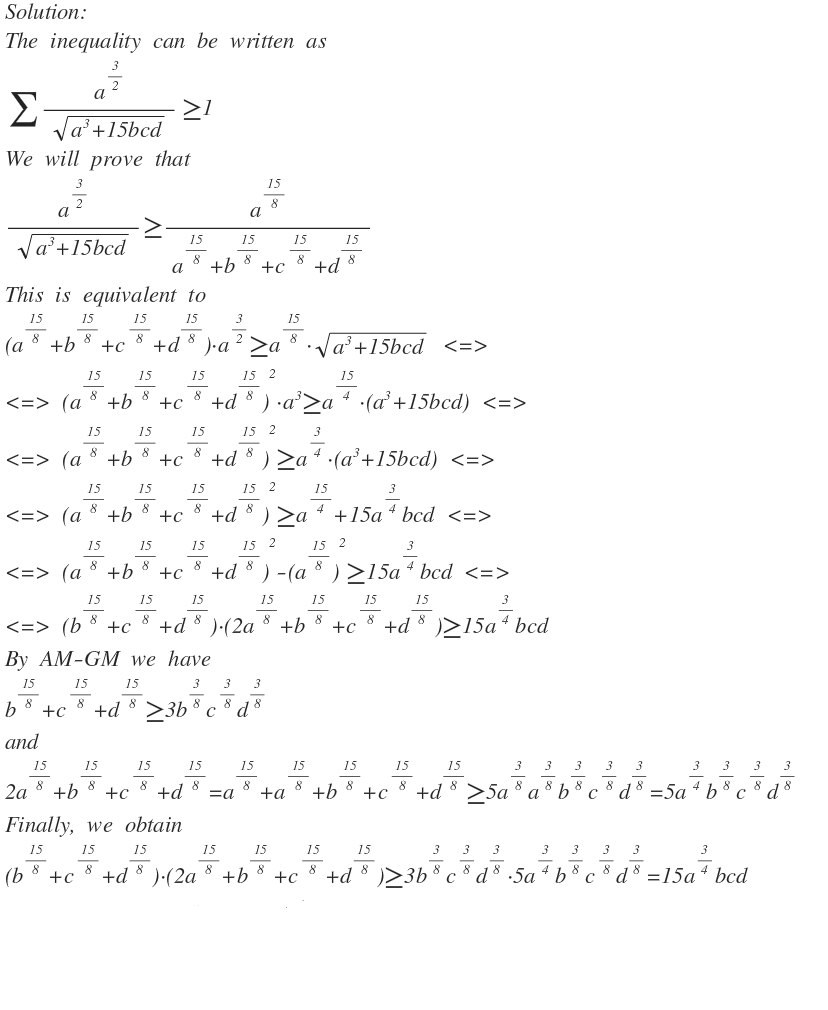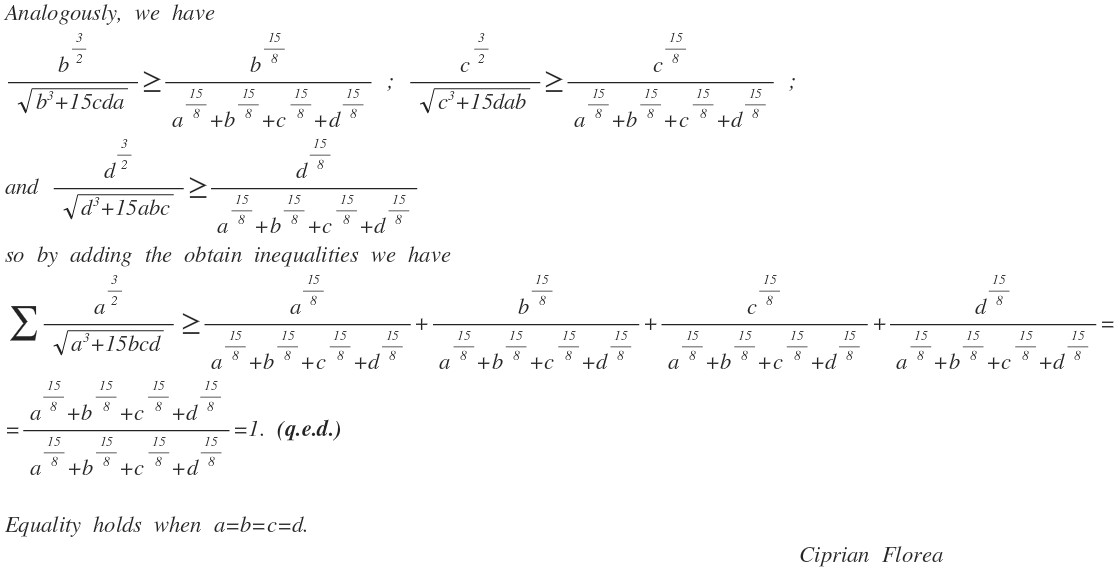Inequality 2017
a 3 + 1 5 b c d a 3 + b 3 + 1 5 c d a b 3 + c 3 + 1 5 d a b c 3 + d 3 + 1 5 a b c d 3
Find the minimum value of the expression above, where a , b , c and d are positive real numbers.
The answer is 1.
This section requires Javascript.
You are seeing this because something didn't load right. We suggest you, (a) try
refreshing the page, (b) enabling javascript if it is disabled on your browser and,
finally, (c)
loading the
non-javascript version of this page
. We're sorry about the hassle.
2 solutions


Reminds me of IMO 01/2, which had a similar proof.
Log in to reply
Exactly, it was inspired from there.
Log in to reply
Do you have a clear idea on how to come up with that initial "fudging" inequality? IN my opinion, it always seems very magical as to how they obtain the bound. E.g. if 15 became 80, then I don't know what to try next.
I Upvoted your solution as brilliant, interesting, and helpful! I see a typo though. It says b 8 1 5 + c 8 1 5 + d 8 1 5 ≥ 3 a 8 3 b 8 3 c 8 3 , when it should say b 8 1 5 + c 8 1 5 + d 8 1 5 ≥ 3 a 8 5 b 8 5 c 8 5 . Note: the typo does not affect the correctness of the solution.
Sorry, the solution is incorrect.
Using AM-GM inequality , we have:
a 3 + 1 5 b c d a 3 + b 3 + 1 5 c d a b 3 + c 3 + 1 5 d a b c 3 + d 3 + 1 5 a b c d 3 ≥ 4 8 a 3 + 1 5 b c d a 3 × b 3 + 1 5 c d a b 3 × c 3 + 1 5 d a b c 3 × d 3 + 1 5 a b c d 3 ≥ 4 8 ( 1 6 1 ) 4 Equality occurs when a = b = c = d (see note). ≥ 1
Note: Equality occurs when:
a 3 + 1 5 b c d a 3 = b 3 + 1 5 c d a b 3 ⟹ a = b ⟹ 4 8 a 3 + 1 5 b c d a 3 × b 3 + 1 5 c d a b 3 × c 3 + 1 5 d a b c 3 × d 3 + 1 5 a b c d 3 = c 3 + 1 5 d a b c 3 = d 3 + 1 5 a b c d 3 = c = d = 4 8 a 3 + 1 5 a 3 a 3 × b 3 + 1 5 b 3 b 3 × c 3 + 1 5 c 3 c 3 × d 3 + 1 5 d 3 d 3 = 4 8 1 6 1 × 1 6 1 × 1 6 1 × 1 6 1 = 4 8 ( 1 6 1 ) 4
Could you please explain the last part of the inequality? The one after you used AM-GM..
Log in to reply
I have added it in the note.
Log in to reply
Unfortunately that is not correct.
Yes, it is true that
1.
∑
a
3
a
3
+
1
5
b
c
d
≥
4
∏
4
a
3
a
3
+
1
5
b
c
d
2. Equality holds when
a
=
b
=
c
=
d
.
3. When
a
=
b
=
c
=
d
, then
4
∏
4
a
3
a
3
+
1
5
b
c
d
=
1
However, that doesn't mean that
∑
a
3
a
3
+
1
5
b
c
d
≥
1
. Let me break it down why. What we have is:
1.
f
(
x
)
≥
g
(
x
)
2. Equality occurs at
x
=
x
∗
.
3.
g
(
x
∗
)
=
M
Then, you are claiming that f ( x ) ≥ M . Do you see why this is not true? Are there obvious counter examples of f ( x ) , g ( x ) ?
Log in to reply
@Calvin Lin – Thanks. I get what you mean. But I can't find a counter example. If you can help. I always have problems with this.
Log in to reply
@Chew-Seong Cheong
–
Counter example:
Take
f
(
x
)
=
2
x
2
+
x
,
g
(
x
)
=
x
2
+
x
.
Clearly
f
(
x
)
≥
g
(
x
)
.
Equality holds when
x
∗
=
0
.
We have
g
(
0
)
=
0
.
However, the minimum of
f
(
x
)
is not 0.
Looking at the graphs should give you a clearer picture of what is happening. Right now, we have f ( x ) ≥ g ( x ) , but no relationship between g ( x ) and g ( x ∗ ) . Becuse of that. it's possible to have some x 0 such that g ( x 0 ) < f ( x 0 ) < g ( x ∗ ) = M , as seen in the counter example.
In order to conclude that f ( x ) ≥ M , one possible condition to also requires is that "The minimum of g ( x ) occurs at x = x ∗ ". In that scenario, we then have the chain of inequalities f ( x ) ≥ g ( x ) ≥ g ( x ∗ ) = M .